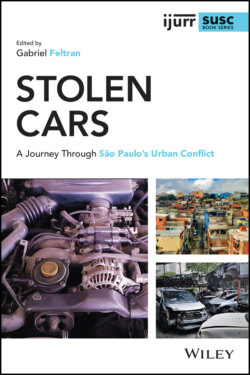Читать книгу Stolen Cars - Группа авторов - Страница 9
A Global Market
ОглавлениеIn this book, we will analytically reconstruct the journey of this Toyota Hilux exchanged by 5 kilos of cocaine that goes to Aron in São Paulo and then carries on to Berlin. We will also look at the journeys of four other cars stolen in São Paulo – a Ford Ka 2018, a Fiat Strada 2014, a Fiat Palio 2011, and a Hyundai HB20 2016. We chose these cars (and their journeys) because of their different consumption profiles and consumers, and because they move within different niches of the same (il)legal economy. The owners of the stolen vehicles and the people who steal them are just a few of the actors inscribed in their journeys, as a long list of men and women, rich and poor, black and white, derive some economic gain from their circulation.
In recent decades, money from illegal markets has structured urban routines (Feltran 2011, 2018), produced urban territories (Batista 2015) and modified the landscapes of cities in the Global South. It has also produced images of global violence (Cohen 2017). The highly unequal transnational, urban economy is produced by everyday life routines touched by various forms of control and regulation (Knowles 2015; Simone 2004; Tsing 2005). Armed violence is one of them and arises only in some specific contexts related to illegal economies. Robberies are much more common in Rio de Janeiro and Johannesburg than in Copenhagen or Montreal, which also have drug dealers and smugglers. Marginality makes money circulate around the world, but the forms it takes vary from place to place.
It took us a while to understand that car theft in São Paulo was feeding global markets. We knew that Brazil’s vibrant legal trade with Mexico hints at the equally vibrant black-market trade between the two countries (Sandoval 2005, 2012a, 2012b). But we had no idea of the magnitude of the illegal car market (see Figure I.2), nor the scale of the auto parts and accessories markets until our research in Europe, perhaps the continent least enamored with car culture (Miller 2001). We conducted research in Europe over the course of several months between 2017 and 2019, specifically in Berlin, London, and Paris. From the moment a car is stolen, as we will see, many people start to make money, in unequal proportions. A lot of vehicles “disappear” every year all over the world. By following five stolen cars, we will learn how this money circulates but also how it impacts the broader social and political dynamics of inequalities and violence reproduction.
Figure I.2 Graph of theft and armed robbery of vehicles. Rate per hundred thousand inhabitants (2013–2016).
Source: The authors, based on data from Data Unodc, InegiMX and the Brazilian Public Security. Forum. The number of Brazilian records corresponds to the sum of thefts and armed robberies.
On the move with the stolen cars we quickly exit the favelas and travel many divergent roads within Brazil – from modest backroads to the largest ports in Latin America where illegal markets link to many places in the so-called Global North. Even to its richest cities. Our primary purposes in analytically reconstructing these journeys are theoretical and methodological. Not least because our research has taught us that, notwithstanding the existence of classic itineraries followed by stolen vehicles, the distinguishing characteristic of (il)legal markets is their perennially improvised and circumstantial nature. Such being the case, method is called for, without caricaturing these markets or treating their operating mechanisms in the abstract; we decided on a multisituated ethnographic investigation, of the type that follows objects and reconstructs typical journeys.
Furthermore, it is necessary to rethink theory in order to comprehend the operations of these mechanisms and their contemporaneous effects according to appropriate scales. We decided to revisit the theoretical point of view in traditional Latin American urban and political thought that recognizes a plurality of orders, in addition to that of the State, governing urban life from the margins. Here, we emphasize the centrality of urban conflict, in São Paulo and in several other metropolises, so as to contemplate inequalities and violence from a relational and transnational perspective.
